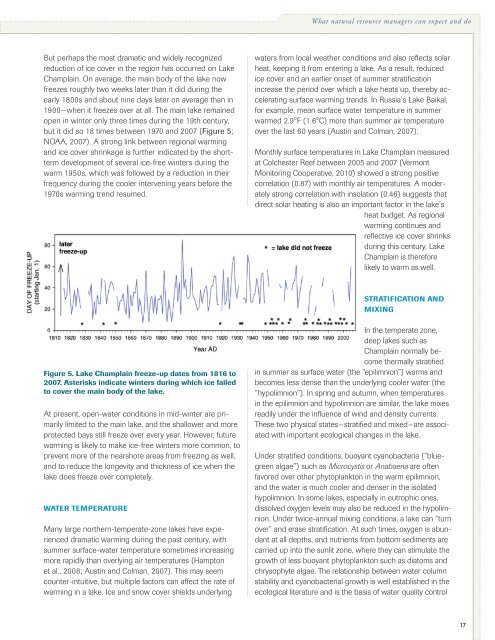Climate Change in the Champlain Basin - The Nature Conservancy
Climate Change in the Champlain Basin - The Nature Conservancy
Climate Change in the Champlain Basin - The Nature Conservancy
You also want an ePaper? Increase the reach of your titles
YUMPU automatically turns print PDFs into web optimized ePapers that Google loves.
What natural resource managers can expect and doBut perhaps <strong>the</strong> most dramatic and widely recognizedreduction of ice cover <strong>in</strong> <strong>the</strong> region has occurred on LakeChampla<strong>in</strong>. On average, <strong>the</strong> ma<strong>in</strong> body of <strong>the</strong> lake nowfreezes roughly two weeks later than it did dur<strong>in</strong>g <strong>the</strong>early 1800s and about n<strong>in</strong>e days later on average than <strong>in</strong>1900—when it freezes over at all. <strong>The</strong> ma<strong>in</strong> lake rema<strong>in</strong>edopen <strong>in</strong> w<strong>in</strong>ter only three times dur<strong>in</strong>g <strong>the</strong> 19th century,but it did so 18 times between 1970 and 2007 (Figure 5;NOAA, 2007). A strong l<strong>in</strong>k between regional warm<strong>in</strong>gand ice cover shr<strong>in</strong>kage is fur<strong>the</strong>r <strong>in</strong>dicated by <strong>the</strong> shorttermdevelopment of several ice-free w<strong>in</strong>ters dur<strong>in</strong>g <strong>the</strong>warm 1950s, which was followed by a reduction <strong>in</strong> <strong>the</strong>irfrequency dur<strong>in</strong>g <strong>the</strong> cooler <strong>in</strong>terven<strong>in</strong>g years before <strong>the</strong>1970s warm<strong>in</strong>g trend resumed.waters from local wea<strong>the</strong>r conditions and also reflects solarheat, keep<strong>in</strong>g it from enter<strong>in</strong>g a lake. As a result, reducedice cover and an earlier onset of summer stratification<strong>in</strong>crease <strong>the</strong> period over which a lake heats up, <strong>the</strong>reby accelerat<strong>in</strong>gsurface warm<strong>in</strong>g trends. In Russia’s Lake Baikal,for example, mean surface water temperature <strong>in</strong> summerwarmed 2.9°F (1.6°C) more than summer air temperatureover <strong>the</strong> last 60 years (Aust<strong>in</strong> and Colman, 2007).Monthly surface temperatures <strong>in</strong> Lake Champla<strong>in</strong> measuredat Colchester Reef between 2005 and 2007 (VermontMonitor<strong>in</strong>g Cooperative, 2010) showed a strong positivecorrelation (0.87) with monthly air temperatures. A moderatelystrong correlation with <strong>in</strong>solation (0.46) suggests thatdirect solar heat<strong>in</strong>g is also an important factor <strong>in</strong> <strong>the</strong> lake’sheat budget. As regionalwarm<strong>in</strong>g cont<strong>in</strong>ues andreflective ice cover shr<strong>in</strong>ksdur<strong>in</strong>g this century, LakeChampla<strong>in</strong> is <strong>the</strong>reforelikely to warm as well.Stratification andmix<strong>in</strong>gFigure 5. Lake Champla<strong>in</strong> freeze-up dates from 1816 to2007. Asterisks <strong>in</strong>dicate w<strong>in</strong>ters dur<strong>in</strong>g which ice failedto cover <strong>the</strong> ma<strong>in</strong> body of <strong>the</strong> lake.At present, open-water conditions <strong>in</strong> mid-w<strong>in</strong>ter are primarilylimited to <strong>the</strong> ma<strong>in</strong> lake, and <strong>the</strong> shallower and moreprotected bays still freeze over every year. However, futurewarm<strong>in</strong>g is likely to make ice-free w<strong>in</strong>ters more common, toprevent more of <strong>the</strong> nearshore areas from freez<strong>in</strong>g as well,and to reduce <strong>the</strong> longevity and thickness of ice when <strong>the</strong>lake does freeze over completely.Water temperatureMany large nor<strong>the</strong>rn-temperate-zone lakes have experienceddramatic warm<strong>in</strong>g dur<strong>in</strong>g <strong>the</strong> past century, withsummer surface-water temperature sometimes <strong>in</strong>creas<strong>in</strong>gmore rapidly than overly<strong>in</strong>g air temperatures (Hamptonet al., 2008; Aust<strong>in</strong> and Colman, 2007). This may seemcounter-<strong>in</strong>tuitive, but multiple factors can affect <strong>the</strong> rate ofwarm<strong>in</strong>g <strong>in</strong> a lake. Ice and snow cover shields underly<strong>in</strong>gIn <strong>the</strong> temperate zone,deep lakes such asChampla<strong>in</strong> normally become<strong>the</strong>rmally stratified<strong>in</strong> summer as surface water (<strong>the</strong> “epilimnion”) warms andbecomes less dense than <strong>the</strong> underly<strong>in</strong>g cooler water (<strong>the</strong>“hypolimnion”). In spr<strong>in</strong>g and autumn, when temperatures<strong>in</strong> <strong>the</strong> epilimnion and hypolimnion are similar, <strong>the</strong> lake mixesreadily under <strong>the</strong> <strong>in</strong>fluence of w<strong>in</strong>d and density currents.<strong>The</strong>se two physical states—stratified and mixed—are associatedwith important ecological changes <strong>in</strong> <strong>the</strong> lake.Under stratified conditions, buoyant cyanobacteria (“bluegreenalgae”) such as Microcystis or Anabaena are oftenfavored over o<strong>the</strong>r phytoplankton <strong>in</strong> <strong>the</strong> warm epilimnion,and <strong>the</strong> water is much cooler and denser <strong>in</strong> <strong>the</strong> isolatedhypolimnion. In some lakes, especially <strong>in</strong> eutrophic ones,dissolved oxygen levels may also be reduced <strong>in</strong> <strong>the</strong> hypolimnion.Under twice-annual mix<strong>in</strong>g conditions, a lake can “turnover” and erase stratification. At such times, oxygen is abundantat all depths, and nutrients from bottom sediments arecarried up <strong>in</strong>to <strong>the</strong> sunlit zone, where <strong>the</strong>y can stimulate <strong>the</strong>growth of less buoyant phytoplankton such as diatoms andchrysophyte algae. <strong>The</strong> relationship between water columnstability and cyanobacterial growth is well established <strong>in</strong> <strong>the</strong>ecological literature and is <strong>the</strong> basis of water quality control17
















